Essay on Antimicrobial Resistant Bacteria: Mechanisms and Articles
VerifiedAdded on 2021/06/14
|15
|3925
|130
Essay
AI Summary
This essay delves into the critical issue of antimicrobial resistant bacteria, examining the mechanisms through which microbes develop resistance to antibiotics. The introduction sets the stage by questioning the effectiveness of current treatments and the evolving nature of bacteria. The essay then poses a research question concerning the mechanisms of antimicrobial resistance, emphasizing the rapid mutation and adaptation of bacteria. It provides a concise overview of resistance mechanisms, including natural resistance, genetic mutation, and the spread of resistance. The core of the essay involves critical appraisals of five research articles from the National Library of Australia, utilizing the CASP checklist. The articles explore various aspects, including mechanisms of resistance, the relationship between virulence and resistance, prevalence in food animals, genetic mutations, and strategies to control multiresistant bacteria. The essay also discusses the levels of evidence presented in the articles, emphasizing the importance of critical evaluation and the limitations of relying solely on the assigned levels of evidence. It highlights the importance of considering factors like study power and potential biases when interpreting research findings. The essay ultimately aims to provide a comprehensive understanding of antimicrobial resistance and the ongoing efforts to combat it.
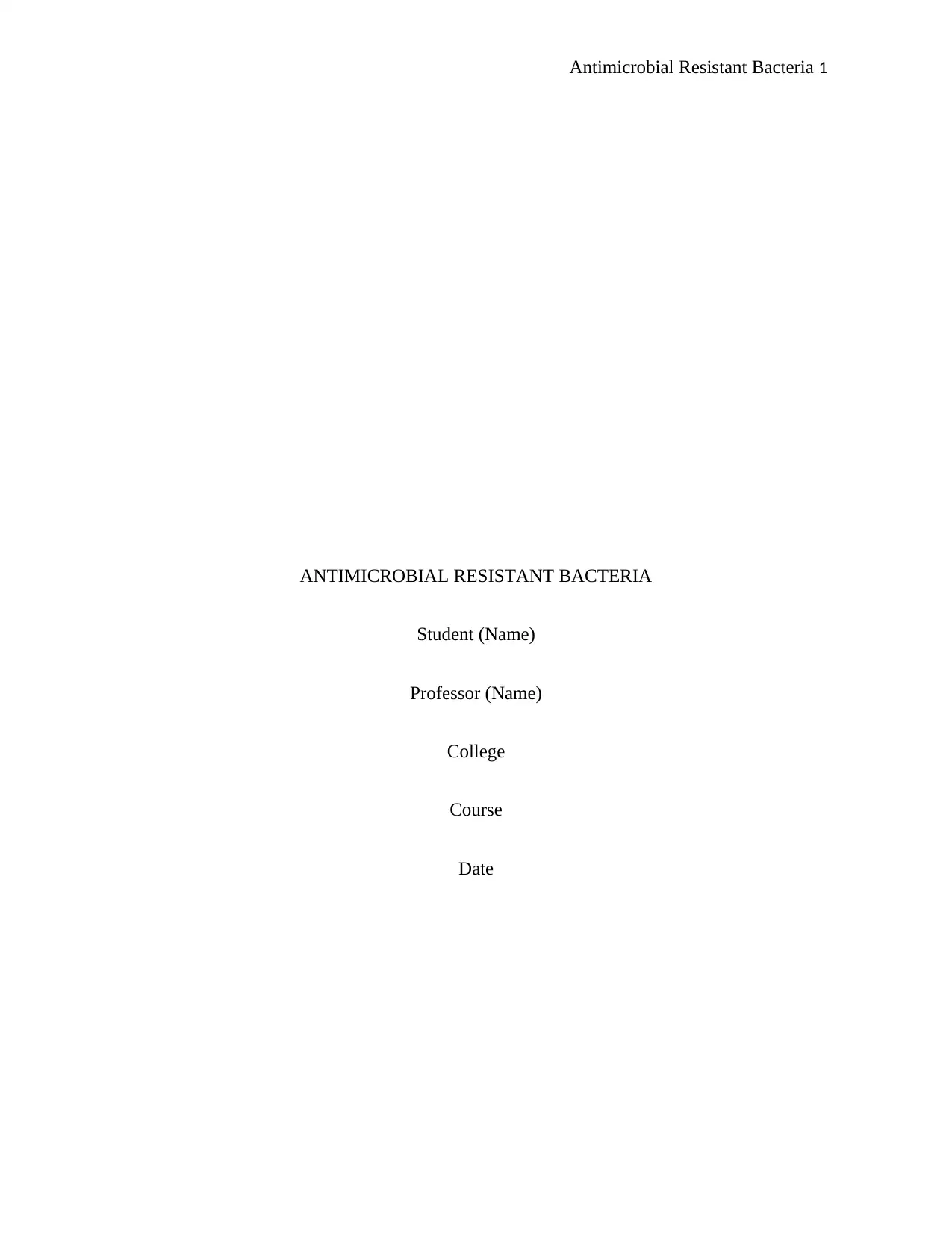
Antimicrobial Resistant Bacteria 1
ANTIMICROBIAL RESISTANT BACTERIA
Student (Name)
Professor (Name)
College
Course
Date
ANTIMICROBIAL RESISTANT BACTERIA
Student (Name)
Professor (Name)
College
Course
Date
Paraphrase This Document
Need a fresh take? Get an instant paraphrase of this document with our AI Paraphraser

Antimicrobial Resistant Bacteria 2
ANTIMICROBIAL RESISTANT BACTERIA
Introduction
Supposing the very same formula and substances that were used approximately 90 years
ago to develop antibiotics are still the same techniques used even today, and the components of
the drugs are still the same. So, do we blame the drug for not for not destroying the bacteria of
the 21st century? Or do we blame the physicians of these days for not being accurate? Or do we
blame we blame everybody using these antibiotics for not adhering to the proper discourse when
administering it? I don’t think so. One fact remains constant: in our fast moving world, far faster
than any period in human history, and so do these bacteria mutate and develop adaptive features
that can withstand the antibiotics (Gullberg et al. 2011). This paper will examine the
antimicrobial resistant bacteria through evaluating a research question from the very same
thematic concern and also give critical appraisal for five different articles addressing the very
same topic. What are the mechanisms through which Microbes resistant to antimicrobial or
antibiotics arise?
Research Question
What are the mechanisms through which Microbes resistant to antimicrobial or
antibiotics arise?
Although we may note some predictions of experts, I would like to categorically point
out that, human knowledge of the future is extremely limited and sometimes farcical. In 1928,
Alexander Fleming, an expert and a professor of bacteriology discovered penicillin, the very first
true antibiotic. Following his breakthrough in the field of medicine, a lot more such discoveries
were made until microbial infections were never a threat to both animals and human lives. But
ANTIMICROBIAL RESISTANT BACTERIA
Introduction
Supposing the very same formula and substances that were used approximately 90 years
ago to develop antibiotics are still the same techniques used even today, and the components of
the drugs are still the same. So, do we blame the drug for not for not destroying the bacteria of
the 21st century? Or do we blame the physicians of these days for not being accurate? Or do we
blame we blame everybody using these antibiotics for not adhering to the proper discourse when
administering it? I don’t think so. One fact remains constant: in our fast moving world, far faster
than any period in human history, and so do these bacteria mutate and develop adaptive features
that can withstand the antibiotics (Gullberg et al. 2011). This paper will examine the
antimicrobial resistant bacteria through evaluating a research question from the very same
thematic concern and also give critical appraisal for five different articles addressing the very
same topic. What are the mechanisms through which Microbes resistant to antimicrobial or
antibiotics arise?
Research Question
What are the mechanisms through which Microbes resistant to antimicrobial or
antibiotics arise?
Although we may note some predictions of experts, I would like to categorically point
out that, human knowledge of the future is extremely limited and sometimes farcical. In 1928,
Alexander Fleming, an expert and a professor of bacteriology discovered penicillin, the very first
true antibiotic. Following his breakthrough in the field of medicine, a lot more such discoveries
were made until microbial infections were never a threat to both animals and human lives. But
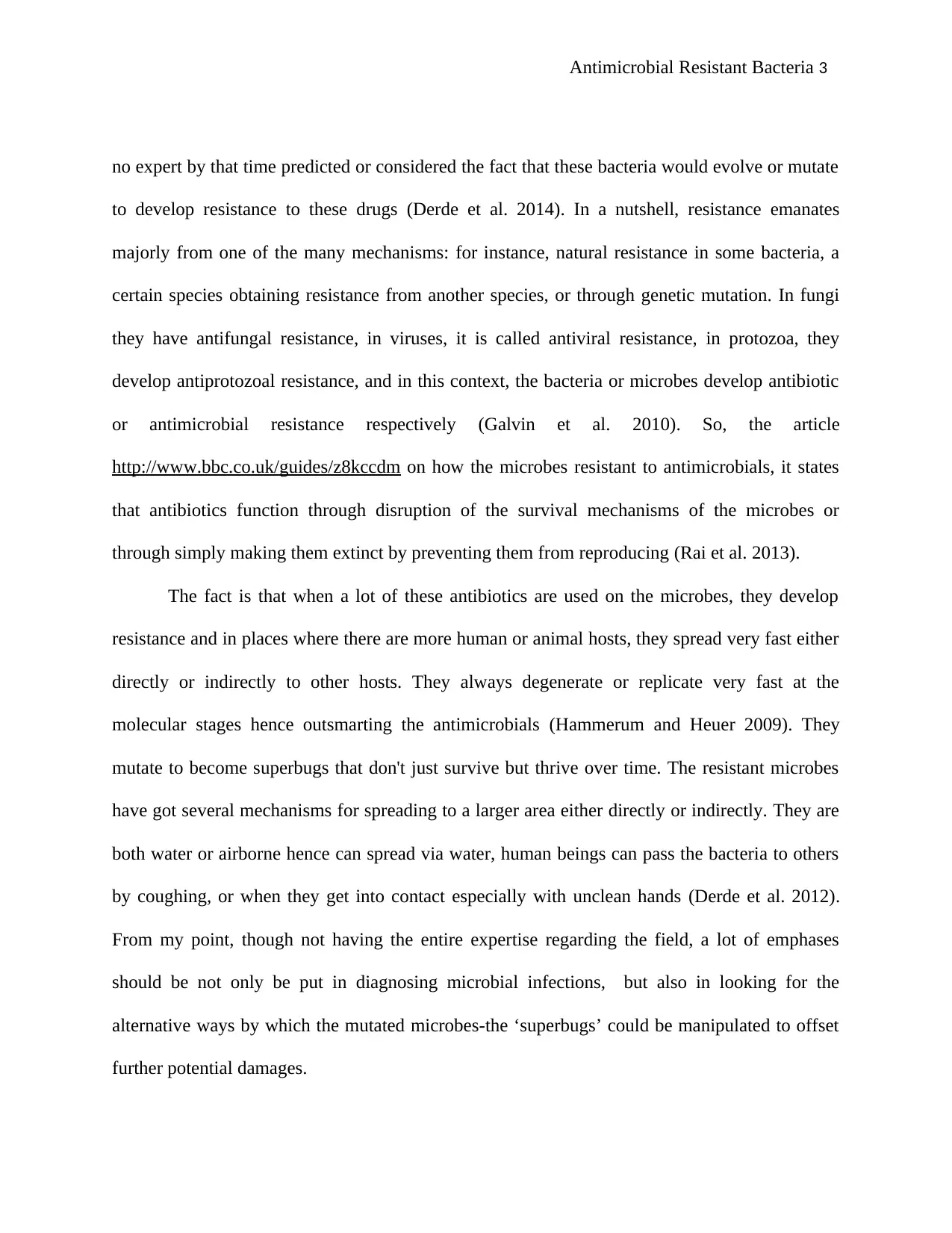
Antimicrobial Resistant Bacteria 3
no expert by that time predicted or considered the fact that these bacteria would evolve or mutate
to develop resistance to these drugs (Derde et al. 2014). In a nutshell, resistance emanates
majorly from one of the many mechanisms: for instance, natural resistance in some bacteria, a
certain species obtaining resistance from another species, or through genetic mutation. In fungi
they have antifungal resistance, in viruses, it is called antiviral resistance, in protozoa, they
develop antiprotozoal resistance, and in this context, the bacteria or microbes develop antibiotic
or antimicrobial resistance respectively (Galvin et al. 2010). So, the article
http://www.bbc.co.uk/guides/z8kccdm on how the microbes resistant to antimicrobials, it states
that antibiotics function through disruption of the survival mechanisms of the microbes or
through simply making them extinct by preventing them from reproducing (Rai et al. 2013).
The fact is that when a lot of these antibiotics are used on the microbes, they develop
resistance and in places where there are more human or animal hosts, they spread very fast either
directly or indirectly to other hosts. They always degenerate or replicate very fast at the
molecular stages hence outsmarting the antimicrobials (Hammerum and Heuer 2009). They
mutate to become superbugs that don't just survive but thrive over time. The resistant microbes
have got several mechanisms for spreading to a larger area either directly or indirectly. They are
both water or airborne hence can spread via water, human beings can pass the bacteria to others
by coughing, or when they get into contact especially with unclean hands (Derde et al. 2012).
From my point, though not having the entire expertise regarding the field, a lot of emphases
should be not only be put in diagnosing microbial infections, but also in looking for the
alternative ways by which the mutated microbes-the ‘superbugs’ could be manipulated to offset
further potential damages.
no expert by that time predicted or considered the fact that these bacteria would evolve or mutate
to develop resistance to these drugs (Derde et al. 2014). In a nutshell, resistance emanates
majorly from one of the many mechanisms: for instance, natural resistance in some bacteria, a
certain species obtaining resistance from another species, or through genetic mutation. In fungi
they have antifungal resistance, in viruses, it is called antiviral resistance, in protozoa, they
develop antiprotozoal resistance, and in this context, the bacteria or microbes develop antibiotic
or antimicrobial resistance respectively (Galvin et al. 2010). So, the article
http://www.bbc.co.uk/guides/z8kccdm on how the microbes resistant to antimicrobials, it states
that antibiotics function through disruption of the survival mechanisms of the microbes or
through simply making them extinct by preventing them from reproducing (Rai et al. 2013).
The fact is that when a lot of these antibiotics are used on the microbes, they develop
resistance and in places where there are more human or animal hosts, they spread very fast either
directly or indirectly to other hosts. They always degenerate or replicate very fast at the
molecular stages hence outsmarting the antimicrobials (Hammerum and Heuer 2009). They
mutate to become superbugs that don't just survive but thrive over time. The resistant microbes
have got several mechanisms for spreading to a larger area either directly or indirectly. They are
both water or airborne hence can spread via water, human beings can pass the bacteria to others
by coughing, or when they get into contact especially with unclean hands (Derde et al. 2012).
From my point, though not having the entire expertise regarding the field, a lot of emphases
should be not only be put in diagnosing microbial infections, but also in looking for the
alternative ways by which the mutated microbes-the ‘superbugs’ could be manipulated to offset
further potential damages.
⊘ This is a preview!⊘
Do you want full access?
Subscribe today to unlock all pages.

Trusted by 1+ million students worldwide
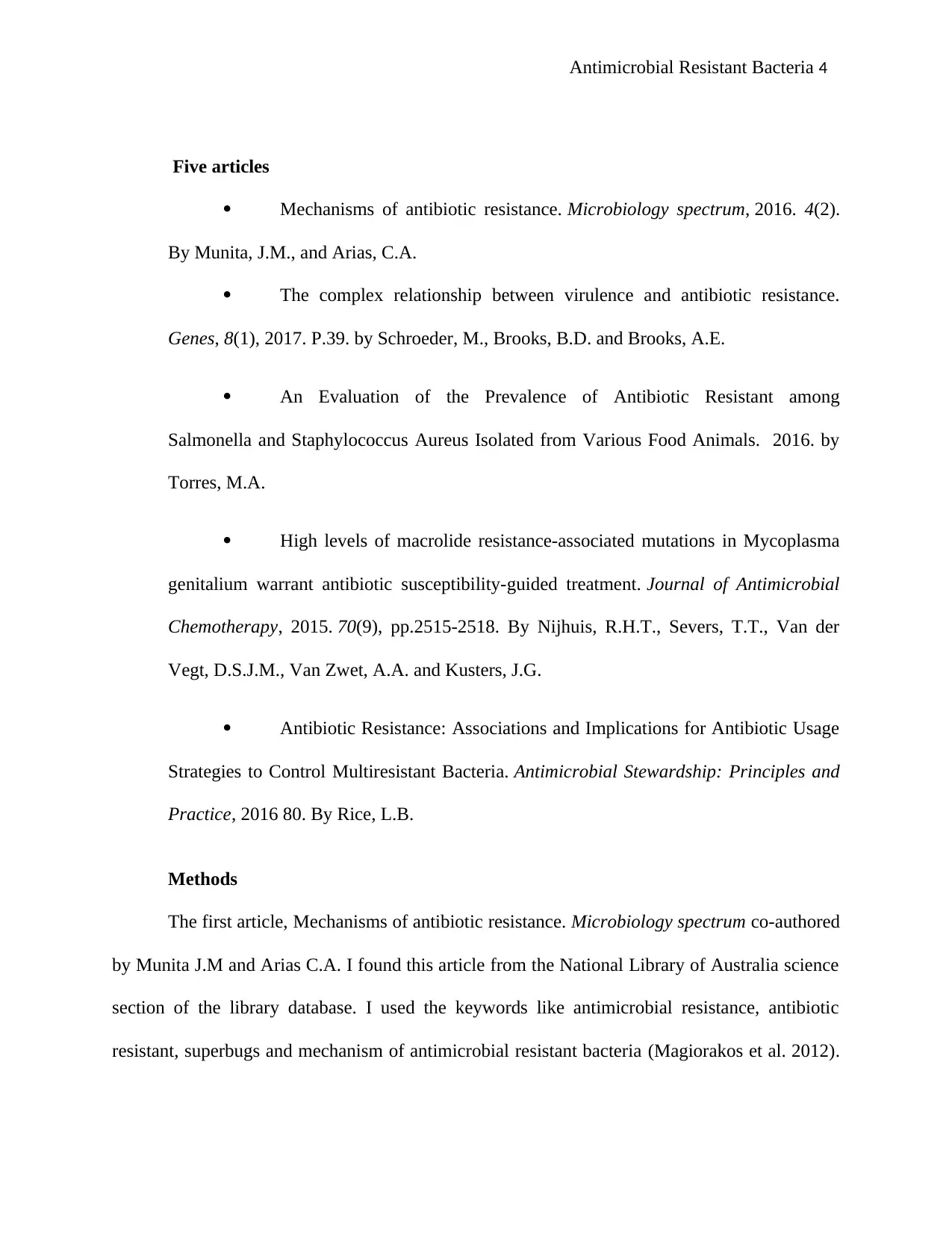
Antimicrobial Resistant Bacteria 4
Five articles
Mechanisms of antibiotic resistance. Microbiology spectrum, 2016. 4(2).
By Munita, J.M., and Arias, C.A.
The complex relationship between virulence and antibiotic resistance.
Genes, 8(1), 2017. P.39. by Schroeder, M., Brooks, B.D. and Brooks, A.E.
An Evaluation of the Prevalence of Antibiotic Resistant among
Salmonella and Staphylococcus Aureus Isolated from Various Food Animals. 2016. by
Torres, M.A.
High levels of macrolide resistance-associated mutations in Mycoplasma
genitalium warrant antibiotic susceptibility-guided treatment. Journal of Antimicrobial
Chemotherapy, 2015. 70(9), pp.2515-2518. By Nijhuis, R.H.T., Severs, T.T., Van der
Vegt, D.S.J.M., Van Zwet, A.A. and Kusters, J.G.
Antibiotic Resistance: Associations and Implications for Antibiotic Usage
Strategies to Control Multiresistant Bacteria. Antimicrobial Stewardship: Principles and
Practice, 2016 80. By Rice, L.B.
Methods
The first article, Mechanisms of antibiotic resistance. Microbiology spectrum co-authored
by Munita J.M and Arias C.A. I found this article from the National Library of Australia science
section of the library database. I used the keywords like antimicrobial resistance, antibiotic
resistant, superbugs and mechanism of antimicrobial resistant bacteria (Magiorakos et al. 2012).
Five articles
Mechanisms of antibiotic resistance. Microbiology spectrum, 2016. 4(2).
By Munita, J.M., and Arias, C.A.
The complex relationship between virulence and antibiotic resistance.
Genes, 8(1), 2017. P.39. by Schroeder, M., Brooks, B.D. and Brooks, A.E.
An Evaluation of the Prevalence of Antibiotic Resistant among
Salmonella and Staphylococcus Aureus Isolated from Various Food Animals. 2016. by
Torres, M.A.
High levels of macrolide resistance-associated mutations in Mycoplasma
genitalium warrant antibiotic susceptibility-guided treatment. Journal of Antimicrobial
Chemotherapy, 2015. 70(9), pp.2515-2518. By Nijhuis, R.H.T., Severs, T.T., Van der
Vegt, D.S.J.M., Van Zwet, A.A. and Kusters, J.G.
Antibiotic Resistance: Associations and Implications for Antibiotic Usage
Strategies to Control Multiresistant Bacteria. Antimicrobial Stewardship: Principles and
Practice, 2016 80. By Rice, L.B.
Methods
The first article, Mechanisms of antibiotic resistance. Microbiology spectrum co-authored
by Munita J.M and Arias C.A. I found this article from the National Library of Australia science
section of the library database. I used the keywords like antimicrobial resistance, antibiotic
resistant, superbugs and mechanism of antimicrobial resistant bacteria (Magiorakos et al. 2012).
Paraphrase This Document
Need a fresh take? Get an instant paraphrase of this document with our AI Paraphraser
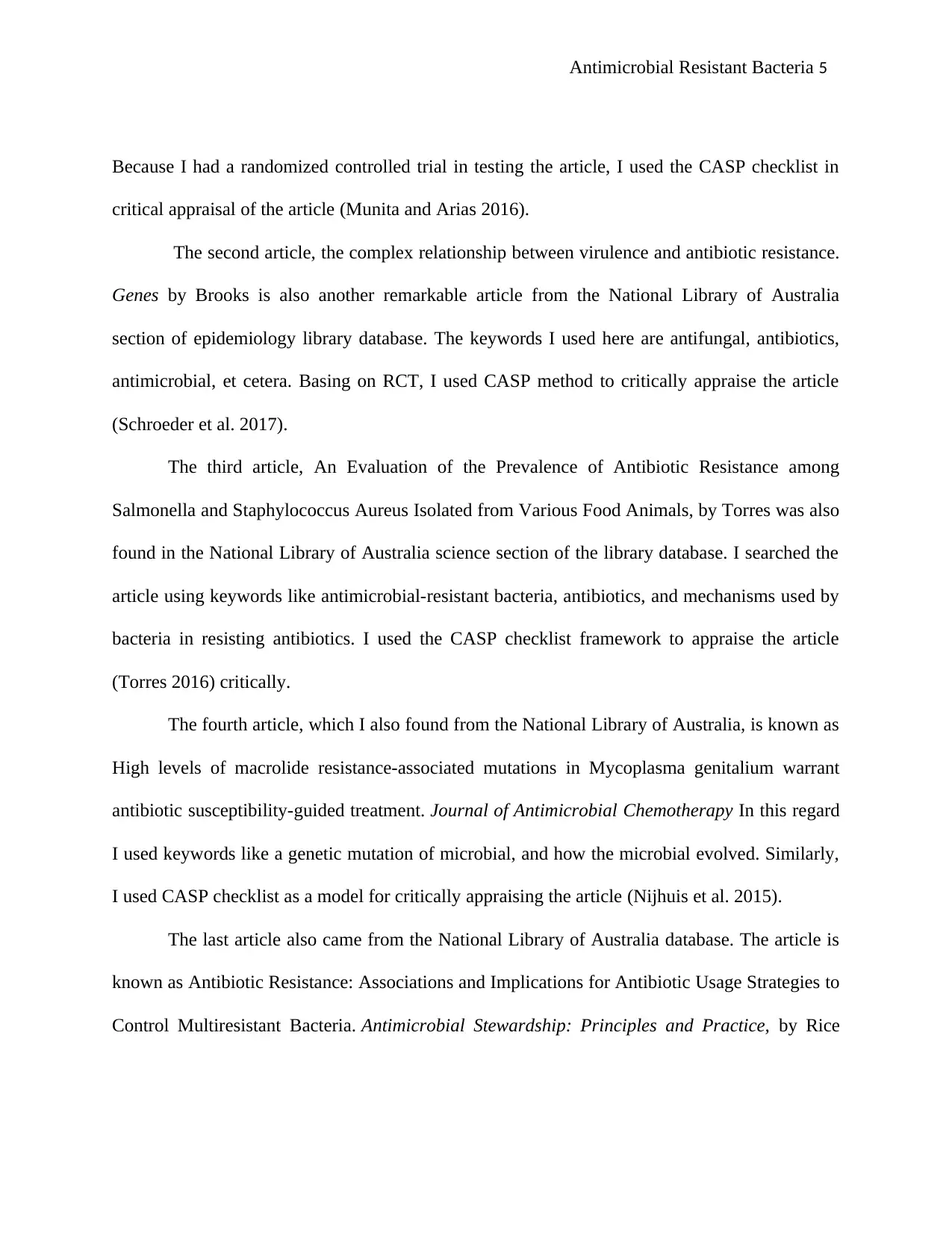
Antimicrobial Resistant Bacteria 5
Because I had a randomized controlled trial in testing the article, I used the CASP checklist in
critical appraisal of the article (Munita and Arias 2016).
The second article, the complex relationship between virulence and antibiotic resistance.
Genes by Brooks is also another remarkable article from the National Library of Australia
section of epidemiology library database. The keywords I used here are antifungal, antibiotics,
antimicrobial, et cetera. Basing on RCT, I used CASP method to critically appraise the article
(Schroeder et al. 2017).
The third article, An Evaluation of the Prevalence of Antibiotic Resistance among
Salmonella and Staphylococcus Aureus Isolated from Various Food Animals, by Torres was also
found in the National Library of Australia science section of the library database. I searched the
article using keywords like antimicrobial-resistant bacteria, antibiotics, and mechanisms used by
bacteria in resisting antibiotics. I used the CASP checklist framework to appraise the article
(Torres 2016) critically.
The fourth article, which I also found from the National Library of Australia, is known as
High levels of macrolide resistance-associated mutations in Mycoplasma genitalium warrant
antibiotic susceptibility-guided treatment. Journal of Antimicrobial Chemotherapy In this regard
I used keywords like a genetic mutation of microbial, and how the microbial evolved. Similarly,
I used CASP checklist as a model for critically appraising the article (Nijhuis et al. 2015).
The last article also came from the National Library of Australia database. The article is
known as Antibiotic Resistance: Associations and Implications for Antibiotic Usage Strategies to
Control Multiresistant Bacteria. Antimicrobial Stewardship: Principles and Practice, by Rice
Because I had a randomized controlled trial in testing the article, I used the CASP checklist in
critical appraisal of the article (Munita and Arias 2016).
The second article, the complex relationship between virulence and antibiotic resistance.
Genes by Brooks is also another remarkable article from the National Library of Australia
section of epidemiology library database. The keywords I used here are antifungal, antibiotics,
antimicrobial, et cetera. Basing on RCT, I used CASP method to critically appraise the article
(Schroeder et al. 2017).
The third article, An Evaluation of the Prevalence of Antibiotic Resistance among
Salmonella and Staphylococcus Aureus Isolated from Various Food Animals, by Torres was also
found in the National Library of Australia science section of the library database. I searched the
article using keywords like antimicrobial-resistant bacteria, antibiotics, and mechanisms used by
bacteria in resisting antibiotics. I used the CASP checklist framework to appraise the article
(Torres 2016) critically.
The fourth article, which I also found from the National Library of Australia, is known as
High levels of macrolide resistance-associated mutations in Mycoplasma genitalium warrant
antibiotic susceptibility-guided treatment. Journal of Antimicrobial Chemotherapy In this regard
I used keywords like a genetic mutation of microbial, and how the microbial evolved. Similarly,
I used CASP checklist as a model for critically appraising the article (Nijhuis et al. 2015).
The last article also came from the National Library of Australia database. The article is
known as Antibiotic Resistance: Associations and Implications for Antibiotic Usage Strategies to
Control Multiresistant Bacteria. Antimicrobial Stewardship: Principles and Practice, by Rice
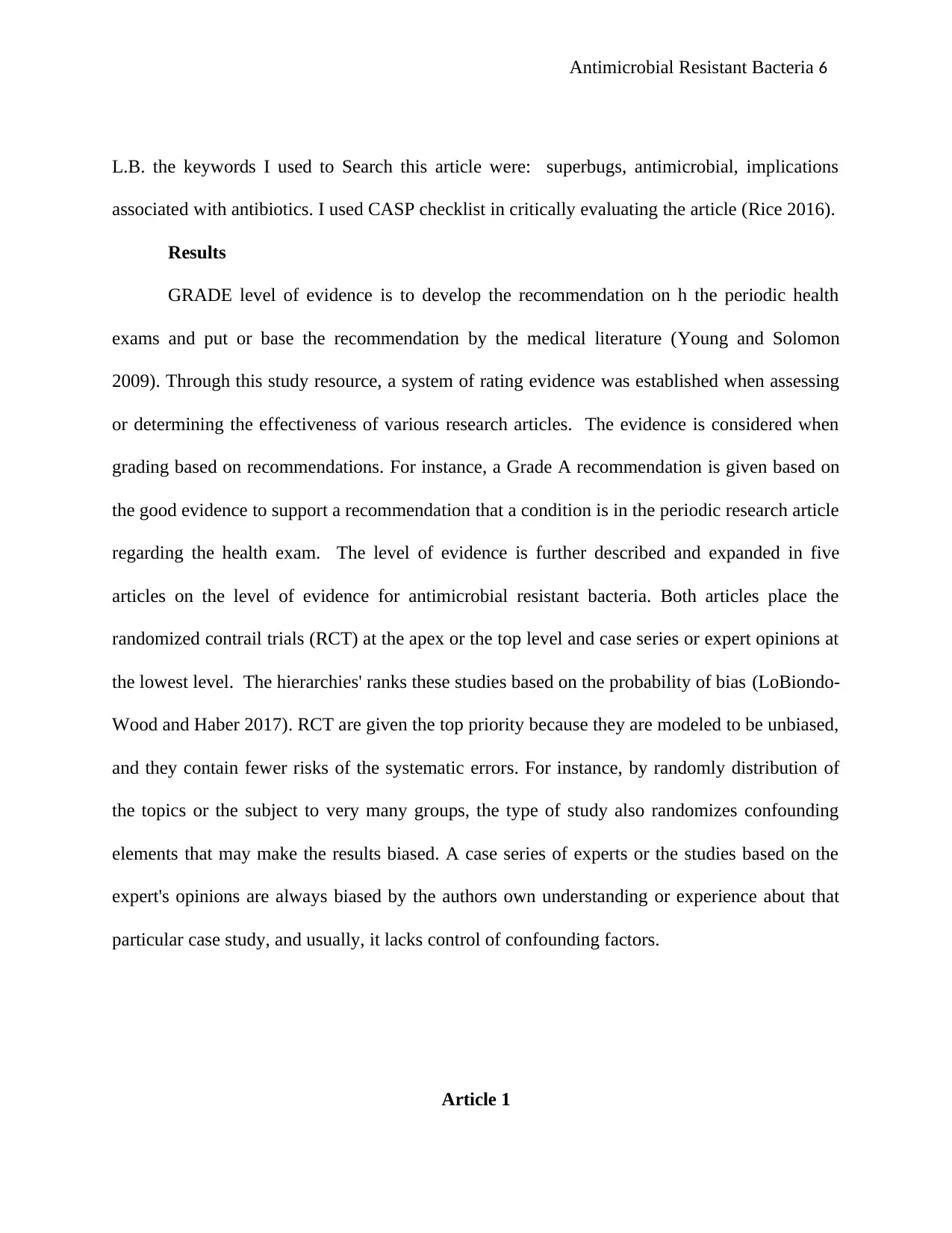
Antimicrobial Resistant Bacteria 6
L.B. the keywords I used to Search this article were: superbugs, antimicrobial, implications
associated with antibiotics. I used CASP checklist in critically evaluating the article (Rice 2016).
Results
GRADE level of evidence is to develop the recommendation on h the periodic health
exams and put or base the recommendation by the medical literature (Young and Solomon
2009). Through this study resource, a system of rating evidence was established when assessing
or determining the effectiveness of various research articles. The evidence is considered when
grading based on recommendations. For instance, a Grade A recommendation is given based on
the good evidence to support a recommendation that a condition is in the periodic research article
regarding the health exam. The level of evidence is further described and expanded in five
articles on the level of evidence for antimicrobial resistant bacteria. Both articles place the
randomized contrail trials (RCT) at the apex or the top level and case series or expert opinions at
the lowest level. The hierarchies' ranks these studies based on the probability of bias (LoBiondo-
Wood and Haber 2017). RCT are given the top priority because they are modeled to be unbiased,
and they contain fewer risks of the systematic errors. For instance, by randomly distribution of
the topics or the subject to very many groups, the type of study also randomizes confounding
elements that may make the results biased. A case series of experts or the studies based on the
expert's opinions are always biased by the authors own understanding or experience about that
particular case study, and usually, it lacks control of confounding factors.
Article 1
L.B. the keywords I used to Search this article were: superbugs, antimicrobial, implications
associated with antibiotics. I used CASP checklist in critically evaluating the article (Rice 2016).
Results
GRADE level of evidence is to develop the recommendation on h the periodic health
exams and put or base the recommendation by the medical literature (Young and Solomon
2009). Through this study resource, a system of rating evidence was established when assessing
or determining the effectiveness of various research articles. The evidence is considered when
grading based on recommendations. For instance, a Grade A recommendation is given based on
the good evidence to support a recommendation that a condition is in the periodic research article
regarding the health exam. The level of evidence is further described and expanded in five
articles on the level of evidence for antimicrobial resistant bacteria. Both articles place the
randomized contrail trials (RCT) at the apex or the top level and case series or expert opinions at
the lowest level. The hierarchies' ranks these studies based on the probability of bias (LoBiondo-
Wood and Haber 2017). RCT are given the top priority because they are modeled to be unbiased,
and they contain fewer risks of the systematic errors. For instance, by randomly distribution of
the topics or the subject to very many groups, the type of study also randomizes confounding
elements that may make the results biased. A case series of experts or the studies based on the
expert's opinions are always biased by the authors own understanding or experience about that
particular case study, and usually, it lacks control of confounding factors.
Article 1
⊘ This is a preview!⊘
Do you want full access?
Subscribe today to unlock all pages.

Trusted by 1+ million students worldwide
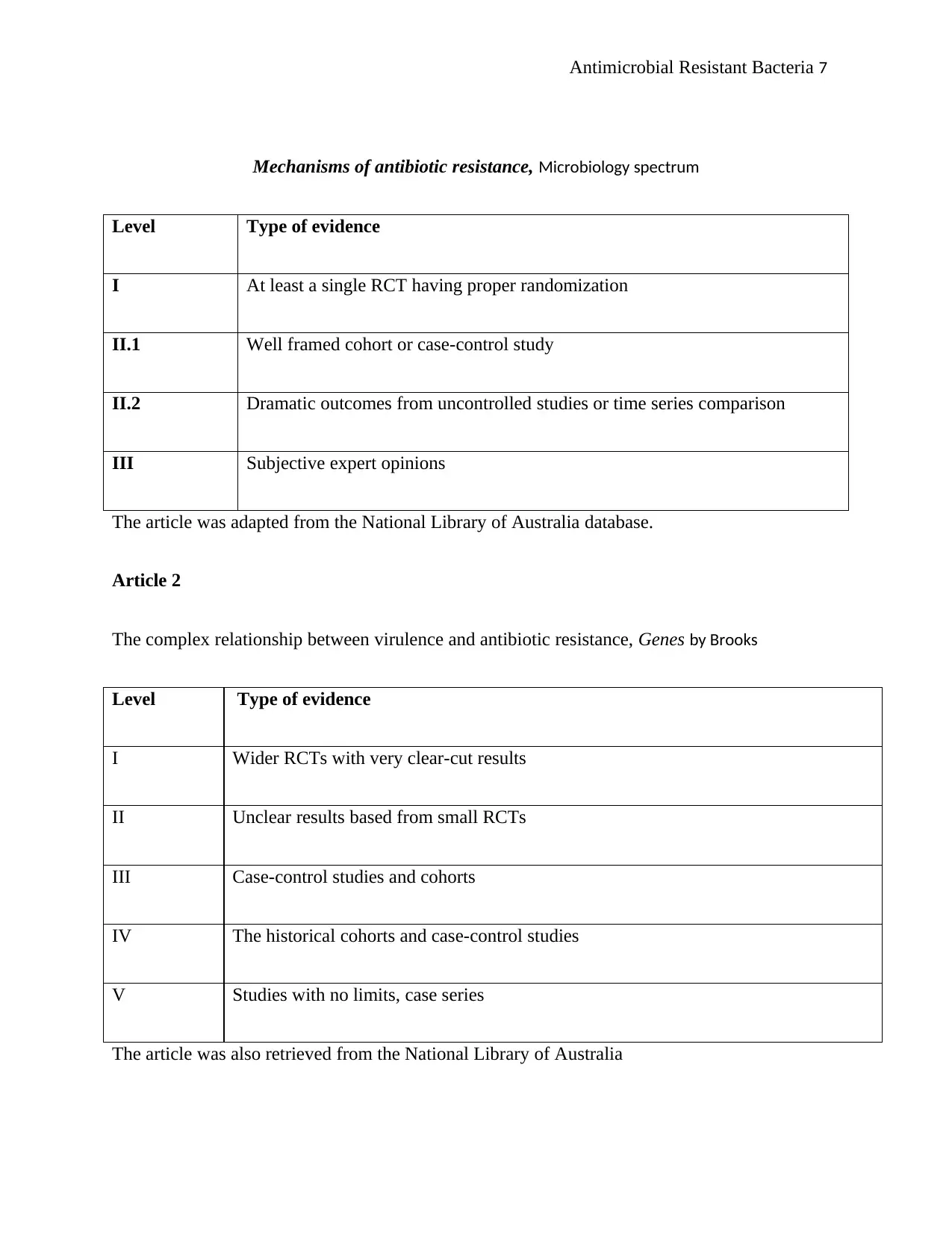
Antimicrobial Resistant Bacteria 7
Mechanisms of antibiotic resistance, Microbiology spectrum
Level Type of evidence
I At least a single RCT having proper randomization
II.1 Well framed cohort or case-control study
II.2 Dramatic outcomes from uncontrolled studies or time series comparison
III Subjective expert opinions
The article was adapted from the National Library of Australia database.
Article 2
The complex relationship between virulence and antibiotic resistance, Genes by Brooks
Level Type of evidence
I Wider RCTs with very clear-cut results
II Unclear results based from small RCTs
III Case-control studies and cohorts
IV The historical cohorts and case-control studies
V Studies with no limits, case series
The article was also retrieved from the National Library of Australia
Mechanisms of antibiotic resistance, Microbiology spectrum
Level Type of evidence
I At least a single RCT having proper randomization
II.1 Well framed cohort or case-control study
II.2 Dramatic outcomes from uncontrolled studies or time series comparison
III Subjective expert opinions
The article was adapted from the National Library of Australia database.
Article 2
The complex relationship between virulence and antibiotic resistance, Genes by Brooks
Level Type of evidence
I Wider RCTs with very clear-cut results
II Unclear results based from small RCTs
III Case-control studies and cohorts
IV The historical cohorts and case-control studies
V Studies with no limits, case series
The article was also retrieved from the National Library of Australia
Paraphrase This Document
Need a fresh take? Get an instant paraphrase of this document with our AI Paraphraser
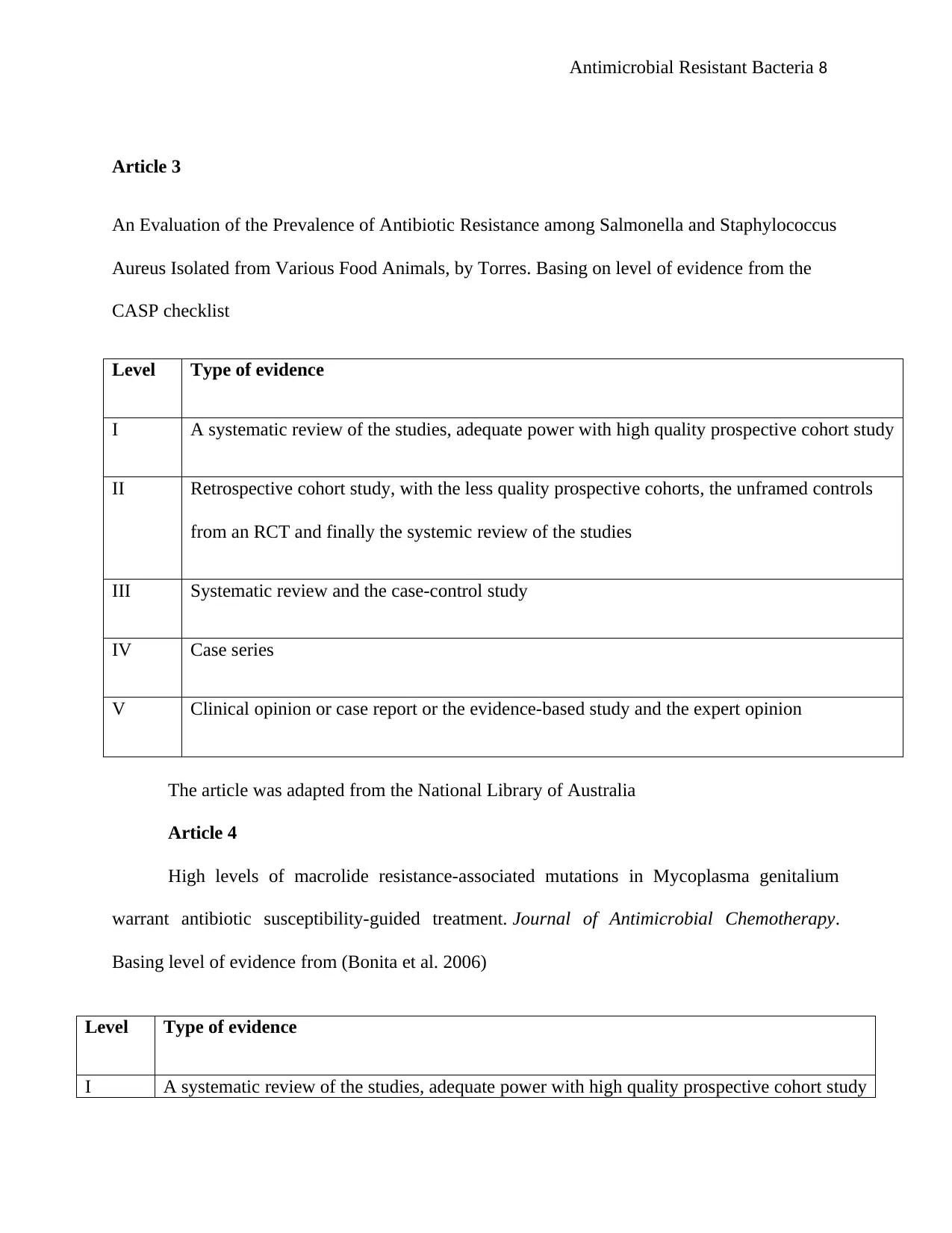
Antimicrobial Resistant Bacteria 8
Article 3
An Evaluation of the Prevalence of Antibiotic Resistance among Salmonella and Staphylococcus
Aureus Isolated from Various Food Animals, by Torres. Basing on level of evidence from the
CASP checklist
Level Type of evidence
I A systematic review of the studies, adequate power with high quality prospective cohort study
II Retrospective cohort study, with the less quality prospective cohorts, the unframed controls
from an RCT and finally the systemic review of the studies
III Systematic review and the case-control study
IV Case series
V Clinical opinion or case report or the evidence-based study and the expert opinion
The article was adapted from the National Library of Australia
Article 4
High levels of macrolide resistance-associated mutations in Mycoplasma genitalium
warrant antibiotic susceptibility-guided treatment. Journal of Antimicrobial Chemotherapy.
Basing level of evidence from (Bonita et al. 2006)
Level Type of evidence
I A systematic review of the studies, adequate power with high quality prospective cohort study
Article 3
An Evaluation of the Prevalence of Antibiotic Resistance among Salmonella and Staphylococcus
Aureus Isolated from Various Food Animals, by Torres. Basing on level of evidence from the
CASP checklist
Level Type of evidence
I A systematic review of the studies, adequate power with high quality prospective cohort study
II Retrospective cohort study, with the less quality prospective cohorts, the unframed controls
from an RCT and finally the systemic review of the studies
III Systematic review and the case-control study
IV Case series
V Clinical opinion or case report or the evidence-based study and the expert opinion
The article was adapted from the National Library of Australia
Article 4
High levels of macrolide resistance-associated mutations in Mycoplasma genitalium
warrant antibiotic susceptibility-guided treatment. Journal of Antimicrobial Chemotherapy.
Basing level of evidence from (Bonita et al. 2006)
Level Type of evidence
I A systematic review of the studies, adequate power with high quality prospective cohort study

Antimicrobial Resistant Bacteria 9
II Retrospective cohort study, with the less quality prospective cohorts, the unframed controls
from an RCT and finally the systemic review of the studies
III Systematic review and the case-control study
IV Case series
V Clinical opinion or case report or the evidence-based study and the expert opinion
The article was also retrieved from the National Library of Australia
Article 5
Antibiotic Resistance: Associations and Implications for Antibiotic Usage Strategies to
Control Multiresistant Bacteria. Antimicrobial Stewardship: Principles and Practice, by Rice
Level Type of evidence
I Wider RCTs with very clear-cut results
II Unclear results based from small RCTs
III Case-control studies and cohorts
IV The historical cohorts and case-control studies
V Studies with no limits, case series
This article was adapted from the National Library of Australia database
II Retrospective cohort study, with the less quality prospective cohorts, the unframed controls
from an RCT and finally the systemic review of the studies
III Systematic review and the case-control study
IV Case series
V Clinical opinion or case report or the evidence-based study and the expert opinion
The article was also retrieved from the National Library of Australia
Article 5
Antibiotic Resistance: Associations and Implications for Antibiotic Usage Strategies to
Control Multiresistant Bacteria. Antimicrobial Stewardship: Principles and Practice, by Rice
Level Type of evidence
I Wider RCTs with very clear-cut results
II Unclear results based from small RCTs
III Case-control studies and cohorts
IV The historical cohorts and case-control studies
V Studies with no limits, case series
This article was adapted from the National Library of Australia database
⊘ This is a preview!⊘
Do you want full access?
Subscribe today to unlock all pages.

Trusted by 1+ million students worldwide
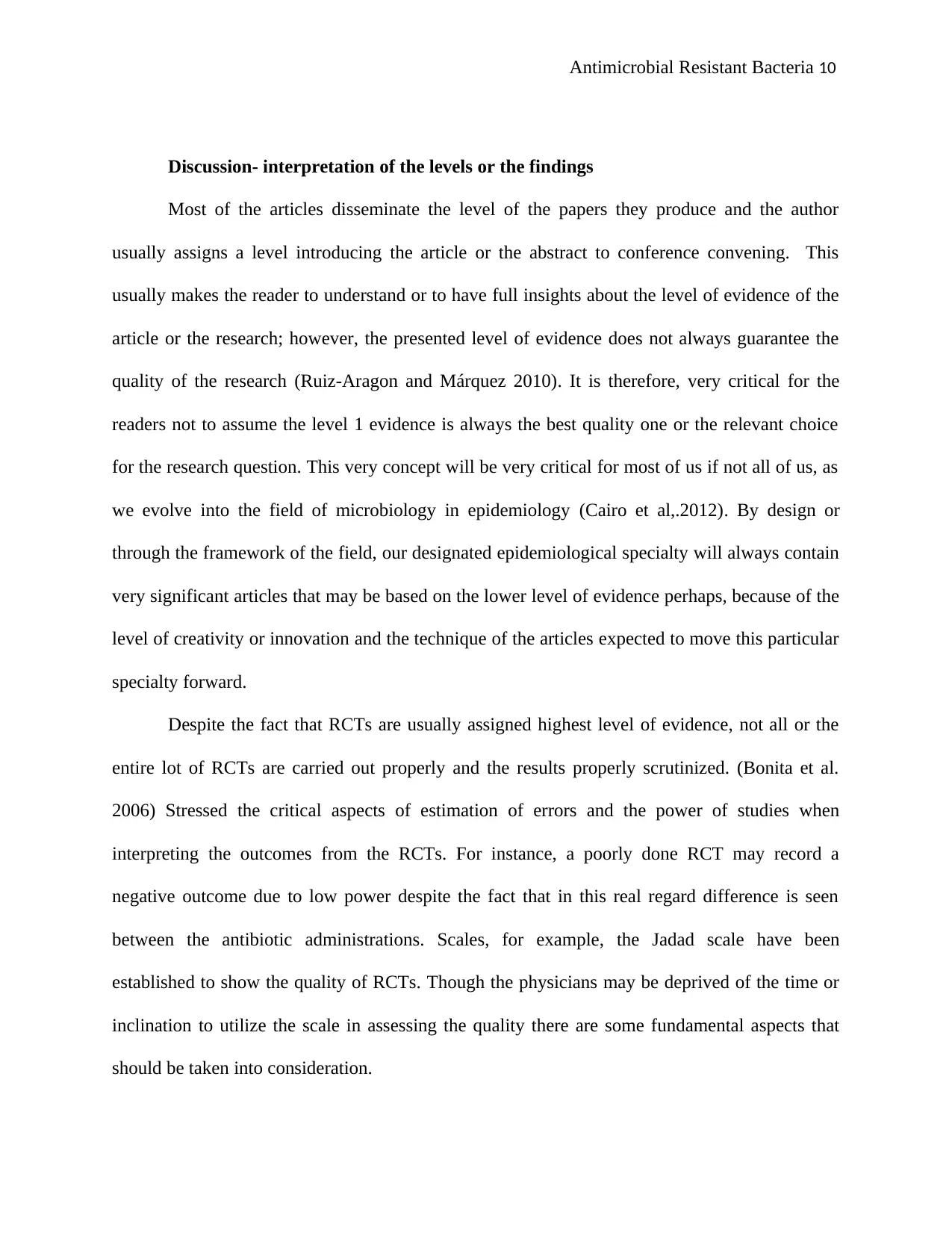
Antimicrobial Resistant Bacteria 10
Discussion- interpretation of the levels or the findings
Most of the articles disseminate the level of the papers they produce and the author
usually assigns a level introducing the article or the abstract to conference convening. This
usually makes the reader to understand or to have full insights about the level of evidence of the
article or the research; however, the presented level of evidence does not always guarantee the
quality of the research (Ruiz-Aragon and Márquez 2010). It is therefore, very critical for the
readers not to assume the level 1 evidence is always the best quality one or the relevant choice
for the research question. This very concept will be very critical for most of us if not all of us, as
we evolve into the field of microbiology in epidemiology (Cairo et al,.2012). By design or
through the framework of the field, our designated epidemiological specialty will always contain
very significant articles that may be based on the lower level of evidence perhaps, because of the
level of creativity or innovation and the technique of the articles expected to move this particular
specialty forward.
Despite the fact that RCTs are usually assigned highest level of evidence, not all or the
entire lot of RCTs are carried out properly and the results properly scrutinized. (Bonita et al.
2006) Stressed the critical aspects of estimation of errors and the power of studies when
interpreting the outcomes from the RCTs. For instance, a poorly done RCT may record a
negative outcome due to low power despite the fact that in this real regard difference is seen
between the antibiotic administrations. Scales, for example, the Jadad scale have been
established to show the quality of RCTs. Though the physicians may be deprived of the time or
inclination to utilize the scale in assessing the quality there are some fundamental aspects that
should be taken into consideration.
Discussion- interpretation of the levels or the findings
Most of the articles disseminate the level of the papers they produce and the author
usually assigns a level introducing the article or the abstract to conference convening. This
usually makes the reader to understand or to have full insights about the level of evidence of the
article or the research; however, the presented level of evidence does not always guarantee the
quality of the research (Ruiz-Aragon and Márquez 2010). It is therefore, very critical for the
readers not to assume the level 1 evidence is always the best quality one or the relevant choice
for the research question. This very concept will be very critical for most of us if not all of us, as
we evolve into the field of microbiology in epidemiology (Cairo et al,.2012). By design or
through the framework of the field, our designated epidemiological specialty will always contain
very significant articles that may be based on the lower level of evidence perhaps, because of the
level of creativity or innovation and the technique of the articles expected to move this particular
specialty forward.
Despite the fact that RCTs are usually assigned highest level of evidence, not all or the
entire lot of RCTs are carried out properly and the results properly scrutinized. (Bonita et al.
2006) Stressed the critical aspects of estimation of errors and the power of studies when
interpreting the outcomes from the RCTs. For instance, a poorly done RCT may record a
negative outcome due to low power despite the fact that in this real regard difference is seen
between the antibiotic administrations. Scales, for example, the Jadad scale have been
established to show the quality of RCTs. Though the physicians may be deprived of the time or
inclination to utilize the scale in assessing the quality there are some fundamental aspects that
should be taken into consideration.
Paraphrase This Document
Need a fresh take? Get an instant paraphrase of this document with our AI Paraphraser
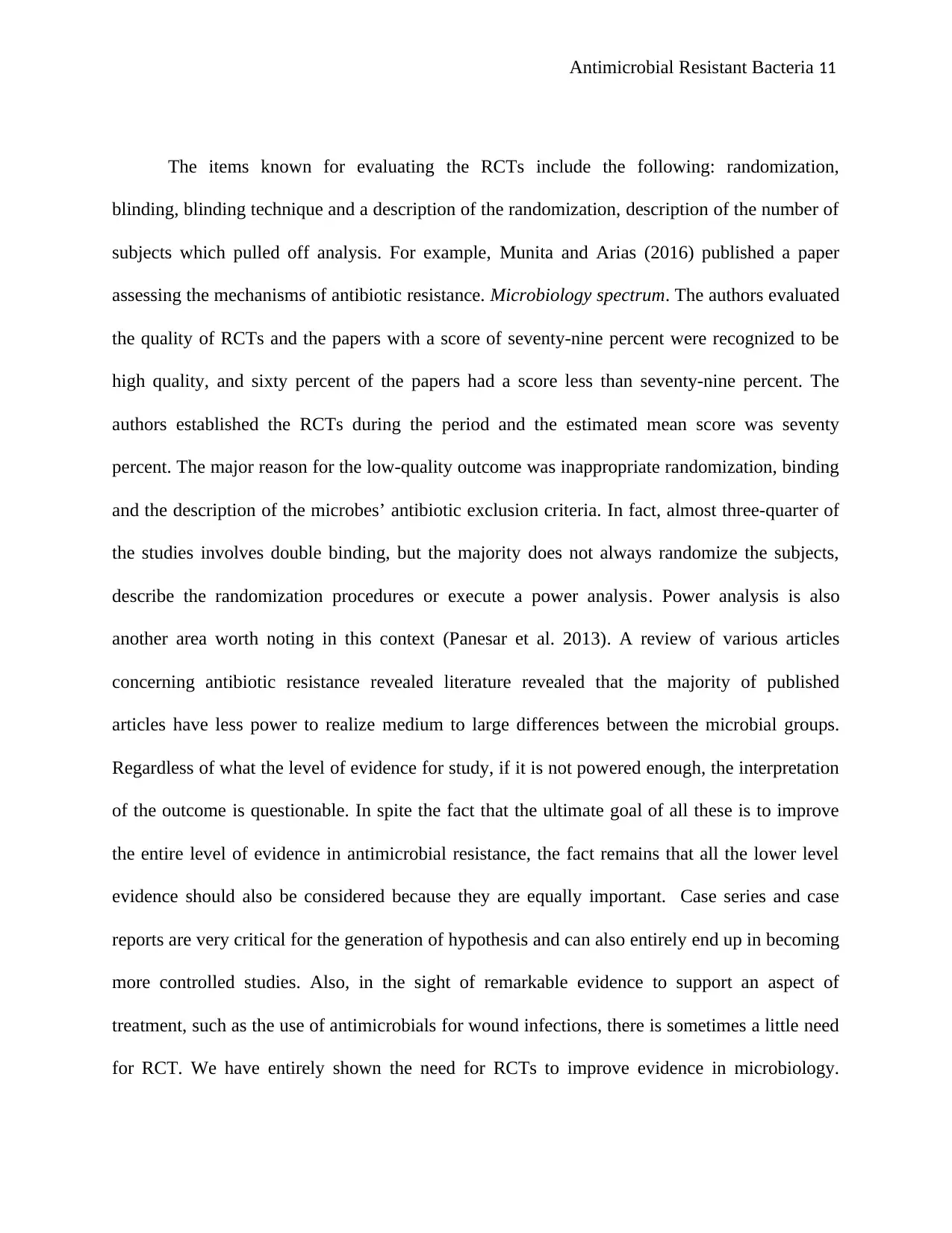
Antimicrobial Resistant Bacteria 11
The items known for evaluating the RCTs include the following: randomization,
blinding, blinding technique and a description of the randomization, description of the number of
subjects which pulled off analysis. For example, Munita and Arias (2016) published a paper
assessing the mechanisms of antibiotic resistance. Microbiology spectrum. The authors evaluated
the quality of RCTs and the papers with a score of seventy-nine percent were recognized to be
high quality, and sixty percent of the papers had a score less than seventy-nine percent. The
authors established the RCTs during the period and the estimated mean score was seventy
percent. The major reason for the low-quality outcome was inappropriate randomization, binding
and the description of the microbes’ antibiotic exclusion criteria. In fact, almost three-quarter of
the studies involves double binding, but the majority does not always randomize the subjects,
describe the randomization procedures or execute a power analysis. Power analysis is also
another area worth noting in this context (Panesar et al. 2013). A review of various articles
concerning antibiotic resistance revealed literature revealed that the majority of published
articles have less power to realize medium to large differences between the microbial groups.
Regardless of what the level of evidence for study, if it is not powered enough, the interpretation
of the outcome is questionable. In spite the fact that the ultimate goal of all these is to improve
the entire level of evidence in antimicrobial resistance, the fact remains that all the lower level
evidence should also be considered because they are equally important. Case series and case
reports are very critical for the generation of hypothesis and can also entirely end up in becoming
more controlled studies. Also, in the sight of remarkable evidence to support an aspect of
treatment, such as the use of antimicrobials for wound infections, there is sometimes a little need
for RCT. We have entirely shown the need for RCTs to improve evidence in microbiology.
The items known for evaluating the RCTs include the following: randomization,
blinding, blinding technique and a description of the randomization, description of the number of
subjects which pulled off analysis. For example, Munita and Arias (2016) published a paper
assessing the mechanisms of antibiotic resistance. Microbiology spectrum. The authors evaluated
the quality of RCTs and the papers with a score of seventy-nine percent were recognized to be
high quality, and sixty percent of the papers had a score less than seventy-nine percent. The
authors established the RCTs during the period and the estimated mean score was seventy
percent. The major reason for the low-quality outcome was inappropriate randomization, binding
and the description of the microbes’ antibiotic exclusion criteria. In fact, almost three-quarter of
the studies involves double binding, but the majority does not always randomize the subjects,
describe the randomization procedures or execute a power analysis. Power analysis is also
another area worth noting in this context (Panesar et al. 2013). A review of various articles
concerning antibiotic resistance revealed literature revealed that the majority of published
articles have less power to realize medium to large differences between the microbial groups.
Regardless of what the level of evidence for study, if it is not powered enough, the interpretation
of the outcome is questionable. In spite the fact that the ultimate goal of all these is to improve
the entire level of evidence in antimicrobial resistance, the fact remains that all the lower level
evidence should also be considered because they are equally important. Case series and case
reports are very critical for the generation of hypothesis and can also entirely end up in becoming
more controlled studies. Also, in the sight of remarkable evidence to support an aspect of
treatment, such as the use of antimicrobials for wound infections, there is sometimes a little need
for RCT. We have entirely shown the need for RCTs to improve evidence in microbiology.

Antimicrobial Resistant Bacteria 12
However, we must also have to recognize the fact that there are a lot of challenges associated,
specifically with randomization and blinding. And even though RCTs may not seem much
effective in this context, but well framed, modeled and conducted case-control studies and cohort
may improve the level of evidence (Wu et al. 2009). Otherwise many contemporary studies tend
to be descriptive and miss a control group. But in some very fundamental cases, observation and
RCTs have found remarkable results regarding this field. The application of these alternative
checklists would generally improve the prospects of the critical appraisal of the articles which
ultimately will increase the entire evidence levels in epidemiology.
Conclusion
In summary, the level of evidence is a critical aspect of appraisals in the field of
epidemiology. Having full comprehension of the levels and why they are assigned to different
articles and abstracts would help the reader to make his or her priorities right concerning the type
of information they want to have. But this is not simply saying that you ignore all the level 4
evidence and use only the level one pieces of evidence, rather all the levels of evidence provide a
framework the reader needs and the reader needs to take a lot of cautionary measures when
scrutinizing and interpreting the evidence. The report also highlights the inherent biases present
in various publications, and throughout its course, the paper emphatically and coherently
examines the research question about antimicrobial resistant bacteria.
However, we must also have to recognize the fact that there are a lot of challenges associated,
specifically with randomization and blinding. And even though RCTs may not seem much
effective in this context, but well framed, modeled and conducted case-control studies and cohort
may improve the level of evidence (Wu et al. 2009). Otherwise many contemporary studies tend
to be descriptive and miss a control group. But in some very fundamental cases, observation and
RCTs have found remarkable results regarding this field. The application of these alternative
checklists would generally improve the prospects of the critical appraisal of the articles which
ultimately will increase the entire evidence levels in epidemiology.
Conclusion
In summary, the level of evidence is a critical aspect of appraisals in the field of
epidemiology. Having full comprehension of the levels and why they are assigned to different
articles and abstracts would help the reader to make his or her priorities right concerning the type
of information they want to have. But this is not simply saying that you ignore all the level 4
evidence and use only the level one pieces of evidence, rather all the levels of evidence provide a
framework the reader needs and the reader needs to take a lot of cautionary measures when
scrutinizing and interpreting the evidence. The report also highlights the inherent biases present
in various publications, and throughout its course, the paper emphatically and coherently
examines the research question about antimicrobial resistant bacteria.
⊘ This is a preview!⊘
Do you want full access?
Subscribe today to unlock all pages.

Trusted by 1+ million students worldwide
1 out of 15
Related Documents
Your All-in-One AI-Powered Toolkit for Academic Success.
+13062052269
info@desklib.com
Available 24*7 on WhatsApp / Email
![[object Object]](/_next/static/media/star-bottom.7253800d.svg)
Unlock your academic potential
Copyright © 2020–2025 A2Z Services. All Rights Reserved. Developed and managed by ZUCOL.





